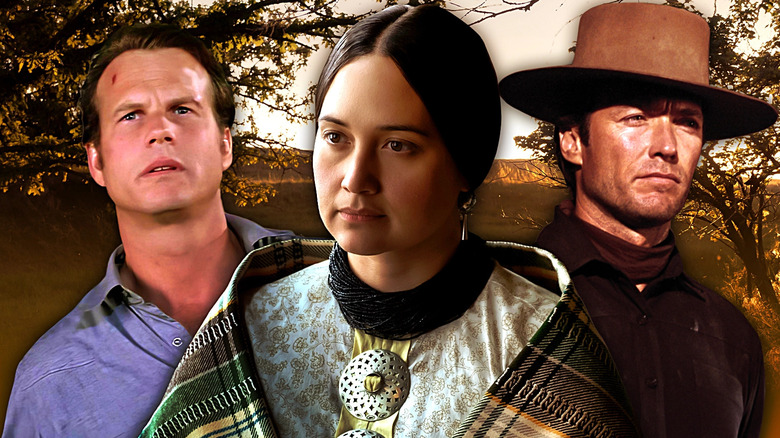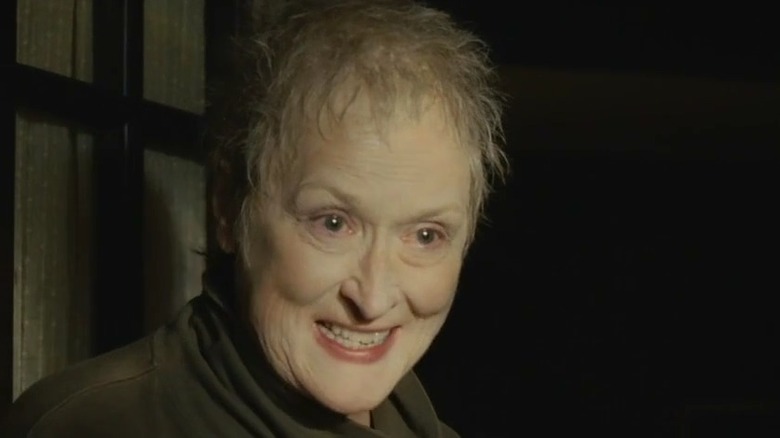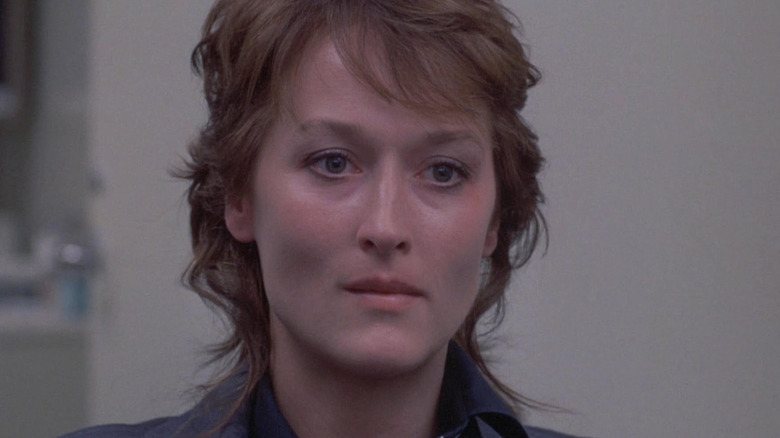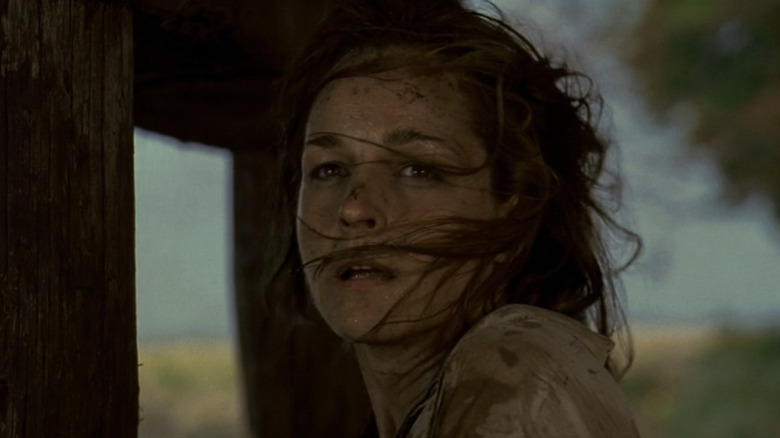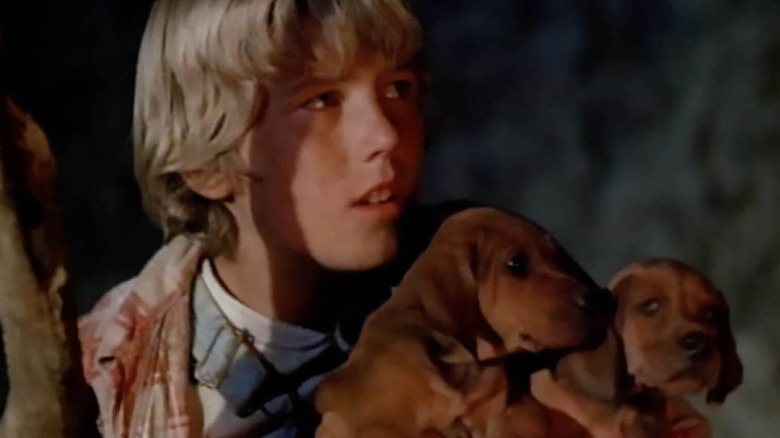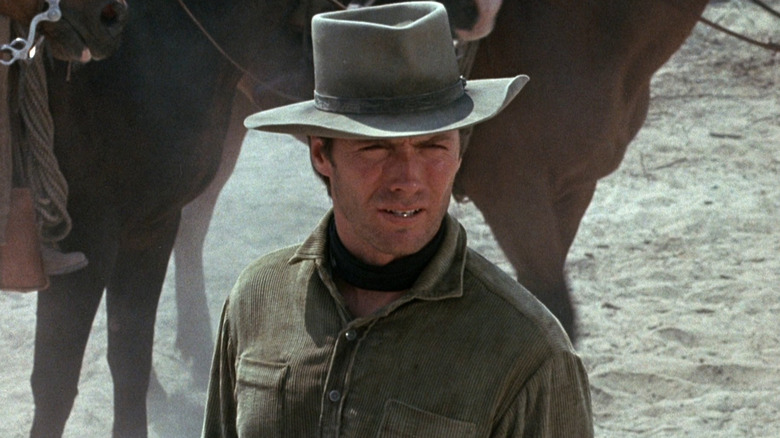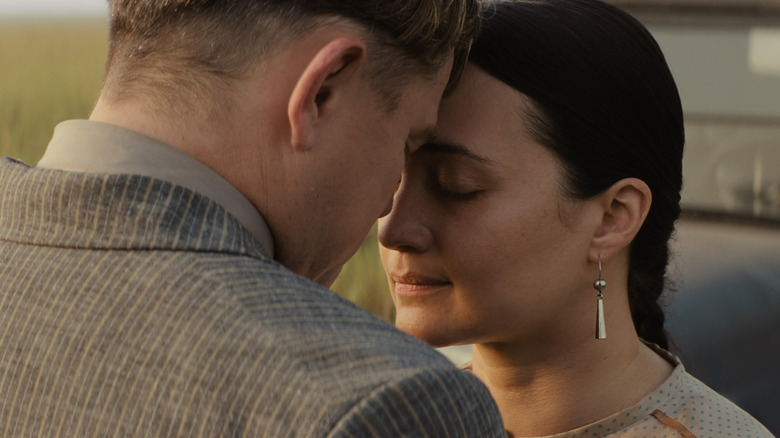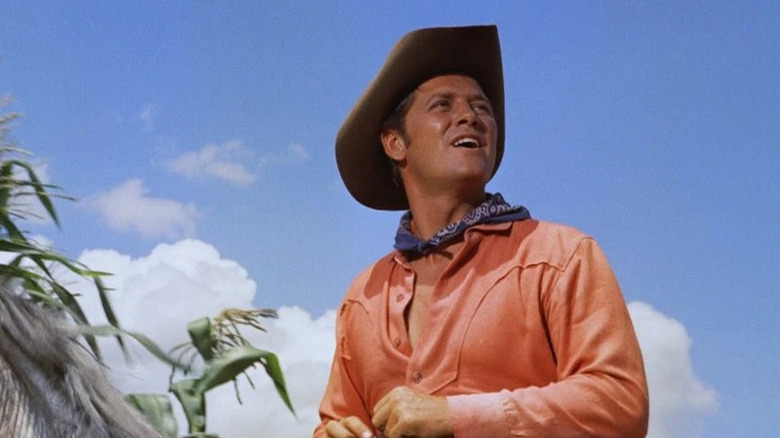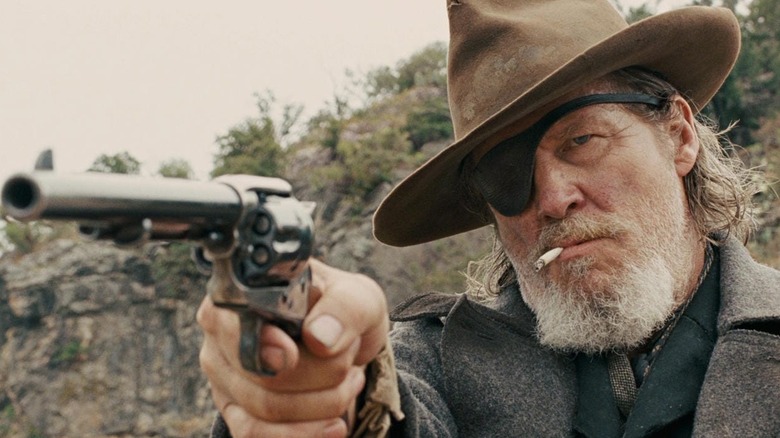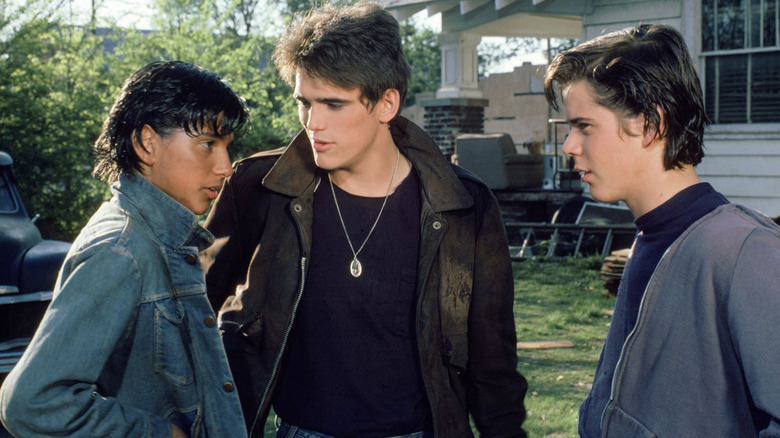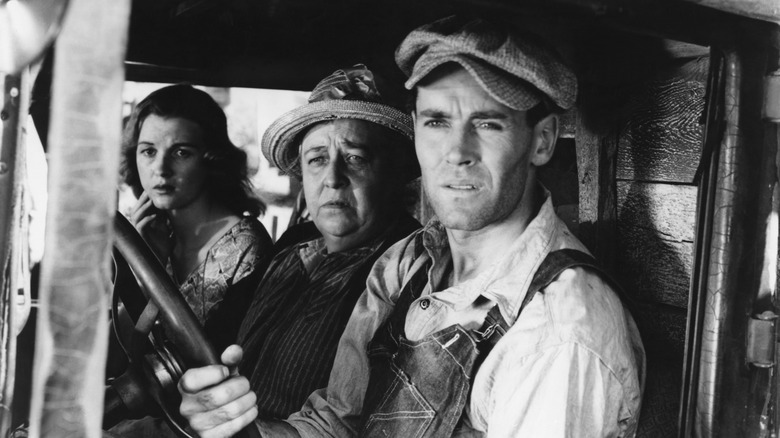10 Best Movies Set In Oklahoma, Ranked
The Sooner State is well represented on the silver screen, with a cinematic legacy that goes back more than a century. In fact, it began shortly after Oklahoma's founding as the 46th state in 1907. The first movie set and filmed in Oklahoma was probably "The Bank Robbery" in 1908, made in Cache, Oklahoma by two lawmen and a photographer. Proving indisputably that there's no business like show business, the cast included the lawmen, a former outlaw, and even the infamous Chief Quanah Parker, war leader of the Kwahadi ("Antelope") of the Comanche Nation. This scenario proves why storytellers have always been drawn to The Sooner State –- it's a wild, weird, and wonderful place, as rich with stories as it historically was with oil.
"The Bank Robbery" was probably the first movie set in Oklahoma, but it was certainly not the last. Not by a long shot. But we're only considering the very best movies set in Oklahoma. Alas, the only thing harder than narrowing our list down to 10 movies was ranking them. To keep this list clean, we're only including movies set in Oklahoma (not necessarily filmed in Oklahoma), where the state plays a pivotal part in the plot. Sorry, Weird Al fans, we're not including "UHF." Nor are we counting movies like "The Killer Inside Me," which was filmed in Oklahoma but set in Texas.
So which films landed on our list? Here are the 10 best movies set in Oklahoma!
August: Osage County
There's an old saying that a great work of art has already found its medium. So "August: Osage County" suffers not from any failures as a film, but because of the inevitable comparisons to its iconic source material. The winner of the 2008 Pulitzer Prize for Drama, "August: Osage County" is one of the most unflinching examinations of the tragedy and comedy that comes with being part of a family in theatre history. And boy howdy, the Weston family is certainly a doozy. Director John Wells' 2013 film adaptation is a showcase for its all-star ensemble, most notably Meryl Streep as mercurial matriarch, the venom-voiced Violet Weston.
But really, everybody in this movie does a lot of acting, including Julia Roberts as the headstrong daughter Barbara Weston, Ewan McGregor as her beleaguered and estranged husband Bill Fordham, Juliette Lewis as the forlorn younger daughter Karen Weston, and Benedict Cumberbatch as the simple-minded "Little" Charles Aiken Jr. This crew — plus Chris Cooper, Margo Martindale, Julianne Nicholson, Abigail Breslin, and Dermot Mulroney too — come together to break bread, and each other's hearts, following the suicide of their long-suffering patriarch, Beverly Weston (Sam Shepherd).
This movie is... a lot. Some may find the family dysfunction hard to endure, but there's no denying its raw, visceral power packs an emotional gut punch. Sure, "August: Osage County" works better on the stage than the screen, but the film is still one of the best movies set in Oklahoma.
Silkwood
Meryl Streep has more Academy Award nominations than we can count on both hands and both feet. Two of them came from movies set in Oklahoma: "August: Osage County" in 2014 (her 18th nomination), and "Silkwood" in 1984 (her fifth nomination). Sorry Okies, but she didn't win any Oscar gold for either role, though "Silkwood" remains one of the best Meryl Streep movies. Streep plays the title character in this biopic based on the true-life story of a corporate whistleblower and activist, Karen Silkwood. Nearly two decades before her "August" costar Julia Roberts won an Oscar for "Erin Brockovich," Streep played a similar role, as a worker at a manufacturing plant for nuclear reactor fuel rods near Crescent, Oklahoma, who suspects her working conditions are, shall we say, less than safe.
Shocking nobody, Silkwood's corporate overlords don't like it when she goes snooping around, making threats and playing mind games that strain her relationship with her boyfriend (Kurt Russell) and endanger her livelihood — and ever her life. The rural Oklahoma setting elevates Silkwood's escalating sense of isolation and dread, contributing to the film's growing tension and suspense as she gathers evidence against her malicious managers who will do anything to stop her from uncovering the truth. "Silkwood" was the first of Streep's four collaborations with director Mike Nichols, and it's arguably the best, as the film remains as fresh, fierce, and urgent today as it was more than 40 years ago.
Twister / Twisters
It's rare when a legacy sequel is as memorable as the original (or even better). So, imagine our surprise when "Twisters" blew us away in 2024. Thus, if you were to ask us which is better, our honest answer would have to be, "Both." Hence, why they're tied on our ranking for best Oklahoma films. Admittedly, the original "Twister" was more of a cultural touchstone, with Jan De Bont's breathtaking blockbuster direction, Bill Paxton and Helen Hunt's charismatic lead performances, and a scenery-chewing performance from an OU-hat wearing Phillip Seymour Hoffman. Swooshing up just shy of $500 million worldwide, "Twister" was second only to "Independence Day" on the global box office chart in 1996.
However, the 2024 followup to "Twisters" far exceeds the extraterrestrial dumpster fire that was 2016's "Independence Day: Resurgence." Part sequel, part reboot, part star vehicle for Glen Powell and Daisy Edgar-Jones, "Twisters" was way better than it had any right to be, or any of us expected. Granted, its $372 million worldwide box office gross is more than a 25% drop from its predecessor, not even accounting for inflation. While "Twisters" was a big hit domestically, its slim profit margin even with a relatively modest $155 million budget means we're not expecting a "Twister 3" (though if there is, we're pitching the title: "Son of Twisters.") Still, we're more than thrilled with the two we have, though rural Oklahoma would appreciate the break from death, destruction, and flying cows.
Where The Red Fern Grows
Few stories can inspire rivers of ugly tears just from their title alone. "Where The Red Fern Grows" is one of them. You are probably familiar with Wilson Rawls' highly autobiographical, 1961 novel about a boy named Billy, and his adventures through Cherokee County, Oklahoma in the 1930s with his two Redbone Coonhounds. There's Old Dan with the brawn, and Little Ann with the brains, and the three of them become a successful hunting team, and form an inseparable bond. That's all we'll say for now. If you know, you know, and that's when the crying begins.
There's the tired old adage that "the book is always better than the movie," and while that is certainly not the case with some stories (e.g. "The Godfather"), it is true with "Where The Red Fern Grows." Which isn't to say that the 1974 adaptation isn't also a two-tissue box tearjerker too. Starring Stewart Petersen as Billy and two-time Academy Award-nominated character James Whitmore as his wise grandpa, "Where The Red Fern Grows" is a faithful retelling that wisely doesn't deviate from the source material. Good on director Norman Tokar for not taking any self-indulgent creative liberties, and realizing this story stands on its own without any reinterpretation. Sure, it inevitably skips over a lot of parts, but that's to be expected, which keeps the film from reaching the same emotional heights as the book. Stlll, few movies pack a bigger emotional punch than "Where The Red Fern Grows," so be sure to pack a hanky when you watch it.
Hang 'Em High
Legend has it Clint Eastwood doesn't overthink it when choosing his films. We certainly can't argue with the results. As a filmmaker, he has directed two Best Picture Academy Award winners ("Unforgiven" and "Million Dollar Baby"), plus numerous Oscar nominations for his colleagues. As an actor? Well, the dude is "The Man With No Name" and "Dirty Harry." Enough said, right? But in a 70-year acting career (starting with the GOAT, 1955's "Revenge of the Creature"), Eastwood has made a fair amount of, shall we say, "unconventional" choices. There's the movie he regrets the most, 1969's "Paint Your Wagon," as well as a movie he made the year before we absolutely love: "Hang 'Em High."
Under the direction of Ted Post -– who also directed Eastwood in the Dirty Harry sequel "Magnum Force" plus episodes of "Rawhide" -– "Hang 'Em High" finds Eastwood playing Jed Cooper, a man who survives a lynching attempt for a crime he did not commit. He becomes a U.S. Marshall in the lawless Oklahoma Territory, with the caveat he not seek vengeance against his attempted murders. Cooper abides by this rule, until the bad guys commit another round of crimes. "Hang 'Em Hang" was an early example of the revisionist western, that throws away the squeaky clean morality of John Wayne for an edgier (and more accurate) take on the Old West. It was a bold choice for a budding movie star, so we're glad Eastwood went with his gut on this one.
Killers of the Flower Moon
Martin Scorsese's career-long examination of the criminal mind has rarely left his cozy confines of New York City ("Mean Streets," "Goodfellas," "Gangs of New York," "The Irishman"). Yes, there were detours to Boston ("The Departed," his sole Best Picture and Best Director winner), and Las Vegas ("Casino"), but Scorsese's crime pictures seem like siblings, or at least close cousins, that deal with similar scenarios and settings. "Killers of the Flower Moon" is both different and the same, a crime film that is simultaneously familiar territory for Scorsese, and a radical departure from his comfort zone.
"Kilers" replaces the urban jungle for the wild west in 1920s northeastern Oklahoma, a time and place when the Osage were the richest people per capita on the planet thanks to oil. Motivated to murder by greed, a criminal cabal systematically kills them for their headrights. This plot is led by William Hale (Robert De Niro), who directs his ne'er do well nephew Ernest Burkhart (Leonardo DiCaprio) to slowly poison his own wife Mollie (Lily Gladstone). "Killers" is, unfortunately, historically accurate, though it inspired divided opinions among indigenous communities because of its focus on the white antagonists. But if you watch "Killers of the Flower Moon" through the figurative lens of history –- and the literal lens of one of the greatest filmmakers ever -– you appreciate it as another excellent Martin Scorsese movie, and the latest chapter in his lifelong fascination with crime.
Oklahoma!
Couldn't have a list of best movies set in Oklahoma without "Oklahoma!," could we? The first collaboration between composer Richard Rodgers and lyricist Oscar Hammerstein II remains one of the most influential, consequential, and frankly spectacular musicals ever, more than 80 years since its 1943 Broadway debut. The soundtrack is the songbook of 20th century Americana, with such instantly recognizable household names as "Oh, What A Beautiful Mornin'," "People Will Say We're In Love," and of course, the title piece. From its original production, to its numerous revivals, "Oklahoma!" has lassoed up 35 Tony Awards and two Pulitzer Prizes, and that's not including the incalculable number of high school and community theater productions. Oh, and it also launched Hugh Jackman and Patrick Wilson's respective careers.
So yeah, "Oklahoma!" is kind of a big deal. But what about the 1955 film? While it can't compete with the Broadway show (few movie musicals can), "Oklahoma!" is more than doin' fine. It's a celebrated award winner in its own right, with four Oscar noms and one win (naturally, for the musical score). While it may not be one of the very best movies based on a Broadway musical, it's still in pretty tall cotton among its genre. What makes this movie sing? The same thing as the theatrical show: likable characters, lovable music, and a simple, homespun love story that's easy to follow but hard to top. Seven decades since the film's release, it continues to be more than O-K-L-A-H-O-M-A.
True Grit (1969) / True Grit (2010)
Don't make us choose between "True Grit" (1969) and "True Grit" (2010). Like pizza and tacos, they're both beautiful in their own way. Each is adapted from Charles Porter's brilliant 1968 novel about headstrong girl Mattie Ross who hires a man with "true grit" to track down the scoundrel who murdered her father into the wilds of Indian Territory, modern-day eastern Oklahoma. She finds her champion in the one-eyed Reuben J. "Rooster" Cogburn, who "loves to pull a cork" (translation: drink heavily). Cogburn's as brave as he is brash, but by the end we discover Mattie is the one with "true grit."
Despite coming out just one year after publication, Henry Hathaway's adaptation strays more from the book, and functions more as a John Wayne star vehicle. Wayne considered it his first decent role in 20 years (we disagree, Duke, as that timeframe includes "The Searchers"), and he delivered a movie star performance of the highest magnitude, defeating Dustin Hoffman in "Midnight Cowboy" to win Wayne's first and only Oscar.
The Duke was replaced by The Dude, with Jeff Bridges donning the eye-patch for The Coen Brother's more faithful 2010 adaptation. While Bridges certainly deserved an Oscar (he won one the year prior for "Crazy Heart"), this adaptation belongs to newcomer Hailee Steinfeld as Mattie. Truly, everybody brought their A-game, making it hard to pick between 1969 and 2010. So we won't. Both are brilliant, and belong on the list of best movies set in Oklahoma.
The Outsiders
Francis Ford Coppola's run from 1972 to 1983 is arguably the greatest of any filmmaker ever and includes such indisputable classics as "The Godfather," "The Conversation," "The Godfather Part II," "Apocalypse Now," and the next film on our list, "The Outsiders." In fact, it's this latter film that might be considered Coppola's last truly great movie. Sure, "Bram Stoker's Dracula" was really entertaining, while "Megalopolis" was "a big, beautiful mess that must be seen," but the rest of his post-1983 oeuvre has been average at best.
Coppola found his muse in the unlikely person of S.E. Hinton, the Tulsa-based novelist who published "The Outsiders" when she was still a teenager. "The Outsiders" is considered by many to be the first YA novel, as the book specifically targeted teens with its tale of class conflict between the "greasers" (poor kids) and the "soc's" (rich kids). "The Outsiders" both honors Hinton novel and Coppola's auteurist vision, as the filmmaker brings his distinctive directorial style to bring just the right amount of romance and melodrama to the source material.
But really, the star of "The Outsiders" are the stars. Coppola's cast is essentially a frat house of future famous people: Patrick Swayze, C. Thomas Howell, Ralph Macchio, Emilio Estevez, Diane Lane, Rob Lowe, Matt Dillion, and Tom Cruise. It's a treat watching these hungry young thesps sink their teeth into their roles as tortured Tulsa teens. Four decades after its release, "The Outsiders" continues to stay cinematic gold.
The Grapes of Wrath
Nothing could take the top spot from "The Grapes of Wrath." John Steinbeck's Pulitzer Prize-winning 1939 novel remains the master writer's masterpiece, and belongs in the company of "Moby Dick," "The Adventures of Huckleberry Finn," and "The Great Gatsby" on any shortlist for "Great American Novel." Both the book and movie tell the story of the Joad family, 1930s tenant farmers impoverished by the double-whammy of The Great Depression and The Dust Bowl. Led by oldest son Tom Joad, the family is forced to join thousands of other "Okies" in exile from their native soil of Oklahoma on "the mother road" in search of work in California.
Adapting the novel into a movie of equal measure was all but impossible. So naturally, John Ford did it. Any list of greatest film directors ever includes John Ford, and "The Grapes of Wrath" is one of the many reasons why. Ford's stark black-and-white imagery speaks to the plight of the protagonists, while he directs his frequent collaborator Henry Fonda to the finest performance of his career. Ford won Best Director, though Best Picture that year went to Alfred Hitchcock's "Rebecca" (another brilliant film, so we won't complain), while James Stewart won Best Actor for "The Philadelphia Story," (arguably a makeup for him losing the year before in "Mr. Smith Goes To Washington.") Awards come and go, but great films stand the test of time. Few stand taller than "The Grapes of Wrath," the best movie set in Oklahoma.
